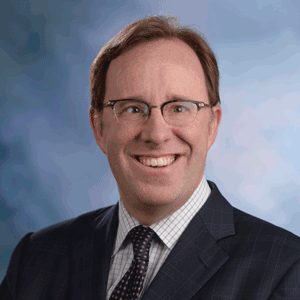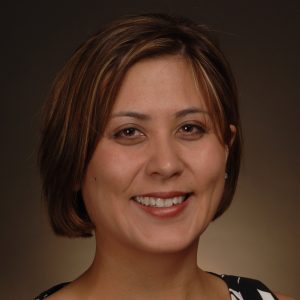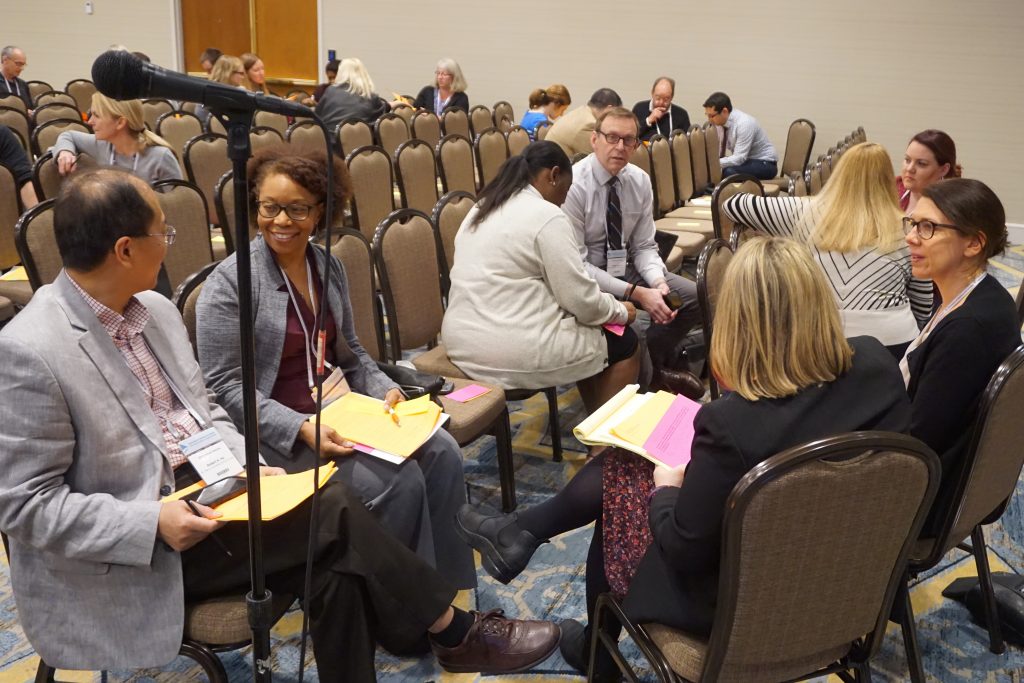The Section on Teaching Methods promotes the communication of ideas, interests, and activities among members of the section and makes recommendations on matters concerning techniques, strategies and methods of teaching, testing, and grading law students.
Chair: Ted Afield, Georgia State University College of Law
Chair-Elect: Kim Holst, Arizona State University Sandra Day O’Connor College of Law


TA: Our focus is on all aspects of teaching that one would encounter in legal education. We try to incorporate offerings that would be relevant whether people are teaching legal writing, clinics, doctrinally, or experiential education—any type of instructional methods that would come to bear in legal academia. Our programming is responsive and speaks to everyone.
Our membership and our section leadership reflect that we come from a variety of backgrounds, and I think we have representation from all the major constituencies in legal academia. This year, because we are trying not to limit our programming to the AALS conference once a year, we are planning to revive a series of teaching-related conference calls that we did a couple of years ago.
KH: I think that sums it up. If we pick a specific pedagogical idea, we think about how that idea impacts all types of teaching no matter what kind of classroom you’re teaching in. Our goal is to show that there is a lot of overlap in our teaching, as opposed to being siloed into different areas.
TA: Ultimately, the hope is for our section to be of interest to everyone in AALS.
TA: The section was recently on the leading edge of flipped classrooms, an issue that predates my time in the leadership of the section. It still comes up from time to time—just like anything else, it is an area where there are always new innovations to discuss. We are also seeing more of an interest in incorporating technology in the classroom.
This year, we have seen more co-teaching, where courses incorporate multiple professors into the same classroom. This concept ranges from the occasional guest lecturer to co-teaching an entire course. This is what we’ll be talking about at the next AALS Annual Meeting in Washington, DC.
KH: Technology is still a big, complicated piece. We are trying to figure out how technology is shaping practice and consequently, how to prepare our students accordingly. That being said, there has been pushback on incorporating too much technology into the classroom. The move toward banning laptops, for example. It’s a rich area with a lot of debate. We’re looking at research outside of the legal academy and looking at the experts to study educational pedagogy.
TA: I do not personally ban [laptops] in my classes. I think students, at the end of the day, should be able to make a choice as to what works best for them. I have no problem talking to them about what the research shows and suggesting that maybe overreliance on laptops is a mistake. Also, by banning them, you run into issues when you have students who need to use them as a disability accommodation. I haven’t wanted to effectively single out those students. For me, it’s just easier to let students make their own decision.
KH: I also let my students make those decisions for themselves and have concerns about accommodations. I am skeptical of some of the research that says students who use laptops aren’t retaining information in the same way. I’m sure that’s true and today’s students are not retaining information in the same way, but I also wonder whether we actually want to train our students that way. I have young kids—elementary, middle, and preschool-age children—who are immersed in technology all the time. I think this research is coming from our own perspective having not grown up in a world surrounded by technology, and that influences opinions against laptops. I try to be more open and recognize that current students have very different skill sets and have been trained differently. They succeeded, nonetheless.
TA: Most of my teaching these days is in the clinical setting. We intentionally incorporate as much technology as possible into the clinic because we want to start training the students with the tools they will actually use in their practice.
TA: That was certainly the case for me when I entered the academy about 10 years ago. I came out of practice; I didn’t come out of a visiting associate professorship (VAP). I think new law professors today are, in many respects, in a much better position than I was. I entered the academy with no idea what good teaching was and learned by trial and error, by asking people and reading whatever resources were available. Many more of those resources are available today compared to a decade ago, as more people have started to produce scholarly literature on this. I would encourage new law teachers to engage in as much of that literature as possible before they start teaching, then find their own teaching style that works for them. It’s a good starting point so that they can feel more comfortable.
I had to go through this a second time, because I started my career as a doctrinal professor then transitioned to clinical. I was comfortable with my doctrinal teaching, but I had never taught clinically before. Thankfully, one of my colleagues at Georgia State, Lisa Bliss, had prepared some good best practices literature that I was able to engage with and use to feel more comfortable teaching pedagogy in a clinical setting.
KH: I also think it’s important to go to as many of your colleagues as possible, or to other teachers whenever you can. I still learn things when I observe other professors, even if they are teaching completely different subjects and class sizes. It’s a great opportunity to see what classroom dynamics exist out there.
 “Small group discusses an exercise during the Section on Teaching Methods program “Bringing Modern Pedagogy to the Traditional Doctrinal Classroom” at the 2019 AALS Annual Meeting.
“Small group discusses an exercise during the Section on Teaching Methods program “Bringing Modern Pedagogy to the Traditional Doctrinal Classroom” at the 2019 AALS Annual Meeting.
TA: I think that’s painting with too broad of a brush. You will find people who give you different opinions on that, who make passionate arguments for purely a lecture-based model or for Socratic-based model. What I draw from that is, as with anything else, there is no perfect way to teach. If there was a perfect way to teach, we would all do it.
There are pros and cons to different teaching methods, and I think some of them are likely emphasized based on the personality of the professor. Finding the style that works for you and allows you to best communicate the knowledge to the students is something that every professor has to go through on their own. I don’t think you can tie pedagogical approaches to specific courses in any kind of systematic way.
TA: All of us in the legal academy have to wrestle with the ABA directives. We need to get more serious about not only defining what our learning outcomes are, but also assessing them and determining whether or not our students are learning what we want them to. Although it seems like a straightforward thing that everyone should do, it’s incredibly difficult.
I am the vice chair of our assessment committee at Georgia State, and we have spent an enormous amount of time developing detailed rubrics to first measure the learning outcomes that the faculty approved and then to get faculty to assess via these rubrics in addition to grades. One thing we realized is that it’s not enough to say that grades are assessment. Grades are one form of assessment, but they don’t really measure whether students have satisfied specific learning outcomes.
It’s a lot of work for the faculty, but the payoff is that we’re starting to get some meaningful data regarding our students. In addition, we are now drilling down to specific areas, which will then allow us to instill interventions in those areas.
KH: We are now realizing that it’s more than just assessing and assigning grades. It’s trying to identify the skills that students need when they leave law school and figuring out if we’re actually doing a good job teaching them. This has been a lot harder to do than people previously thought.
I see innovations in the classroom as supplements to the traditional things that we’ve always done in legal education. – Ted Afield
KH: I don’t think we’ve touched on student evaluations at all. That’s another area with a lot of research currently being done and some controversy in terms of what those evaluations actually show or what value they provide.
TA: Well, part of it is that each law school has to determine the metric of success is for its learning outcomes. Are we shooting for 100 percent? That’s probably not realistic. The question then becomes “What is an acceptable error rate?” Is it okay at 90 percent? 80 percent? What is considered good? That’s a very tough question for law schools to answer. What traditional teaching methods do you think are the most important to not lose sight of as technologic innovations are on the rise?
TA: I see innovations in the classroom as supplements to the traditional things that we’ve always done in legal education. I do believe there is value in at least some level of Socratic interactive instruction. One technological innovation currently in use is clickers, which allow instructors to be even more interactive with students. Rather than just calling on one student, you can pose questions to the entire class and gauge whether they are understanding what you are teaching. That is an example of a core instructional technique being preserved and enhanced by technology.
KH: In my classes, I don’t like to coldcall students. I think the nervousness it instills inhibits their ability to think and be receptive to information. I use the clickers for that reason. My students’ clickers are assigned, so I can double-check to see if a student is struggling and reach out to that student one-on-one instead of calling the student out in front of the class. These are tools to enhance a student’s learning as opposed to replace any of the traditional things we’re doing.
TA: We do, and it seems to work well for us. I think it’s good to have a large leadership contingent because then you know who your core, committed people are and you can tap into them. We mentioned that we’re setting up a series of teaching-related conference calls, which will be followed by a newsletter. We are able to do that because we have a number of people who are willing to shoulder the burden. We started our year off with a conference call to chat about both what we wanted to do for the AALS conference and for additional programming, then divided up tasks.
TA: We plan to start with two conference calls. If we get a ton of interest, we might add more. We should have our first one in the next couple of months. Each call is organized by two people who solicit presenters for the call. I was organizing these calls a couple of years ago, and we had a fair amount of interest just from sending an email blast to the listserv saying, “We’re doing this. If you want to present on a topic that interests you, let us know.” Thanks to a section member who was good with technology, we were also able to make the recordings of these calls available online.
KH: We continue to have our newsletter, in which we have done various things in the past. We’ve had micro-essays and summaries of the calls two years ago, and more. We use the newsletter as a means of supplementing the work that we’re doing.
TA: Because of the program’s length of nearly three hours, we were able to incorporate a discussion of a variety of different teaching techniques from a variety of different types of professors. It feels like every aspect of legal education was represented at that panel, and it was very well-attended.
TA: For this annual meeting, our primary panel, which we are co-sponsoring with the New Law Professors Section, is titled “Expanding the Classroom: Benefits and Challenges of Co-Teaching,” which can encompass a variety of things. That’s what we’re trying to flesh out with this topic. It can be as simple as bringing in a practitioner as a guest lecturer for a specific topic, or as complex as two faculty members with different areas of expertise agreeing to fully co-teach a class from start to finish. I’ve seen people do it a variety of ways at my own home institution. There’s a lot to talk about in terms of what works, what doesn’t, and whether co-teaching is something we should be doing more of or less of. If we’re doing more, how should we be doing it? How is it evaluated by your institution, in terms of your teaching load—as half a class? Do you still get credited for a full class? Does it depend on if it’s a 50/50 split?
There are a lot of different questions that naturally arise, particularly in a more formalized arrangement. I have known some people at Georgia State who have done formal relationships, but I don’t think we have ever developed an institutional policy of how that should be structured. So, I think that’s a very good question, and certainly one of the questions that we hope to have answers for in January.
We’re also co-sponsoring “The Unequal Workplace While Being You Is at Stake” with the Section on Balance in Legal Education, talking about how inequality of treatment shows up in the workplace regardless of the source of that inequality. The program will probe how said inequality relates to one’s occupational health, and how that then relates to legal education and preparing students to deal with the inequality that they will encounter.
Finally, we are also co-sponsoring the New Law Professors section primary panel, titled “So You’re a New Law Professor. Now What? – What We Wish We Had Known.”
TA: My primary goal has been to get us back to the frequency of programming we offered two years ago. The program we had at the AALS conference this past January was excellent, but it was the only major programming that we offered. I want to maintain that level of excellence and expand it throughout the year. That is my primary goal for the year: to increase the number of touchpoints with our membership so that we can be engaged with them throughout the year.
KH: I think it’s important to not limit our section to a program that happens once a year, but rather, to serve as a resource for our members throughout the year. I’m also interested in looking at how pedagogy is changing and perhaps bringing in another expert. It’s challenging to find one every year, but when I move into the chair position, it will have been about three or four years since we offered that. I will be looking outside to see if that is of interest to our membership as well.